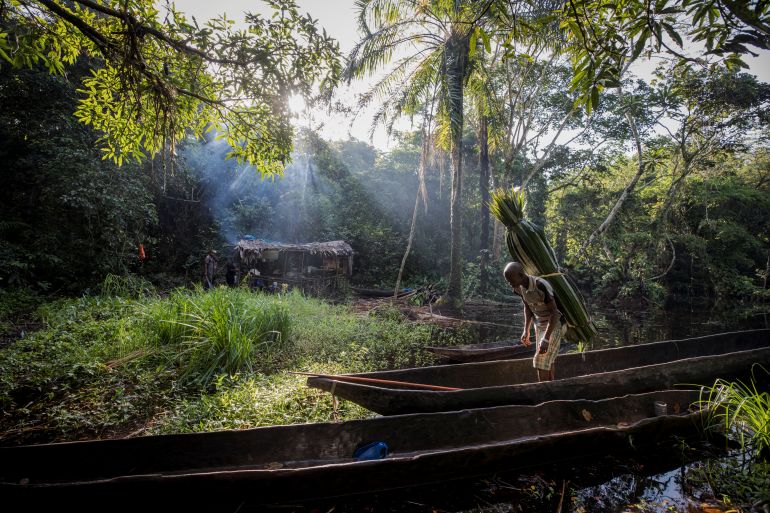To save the Congo basin rainforest, end the conflict in the DRC
Lasting peace can stop deforestation of the world’s second-largest rainforest.

As leaders, activists and policymakers deliberate climate change action at the 2022 United Nations Climate Change Conference (COP27) in Egypt, the world’s forests are once again under the spotlight. When thinking about solutions to the deforestation that threatens them, we need to tackle the root causes of the practice.
One place where the world should focus its attention is the rainforest in the Congo river basin. This is the world’s second-largest tropical rainforest. It stretches over six central African countries and has a capacity to absorb four percent of global carbon dioxide emissions every year.
Keep reading
list of 4 itemsAfter the Hurricane
World’s coral reefs face global bleaching crisis
Why is Germany maintaining economic ties with China?
Some 60 percent of this precious forest falls within the Democratic Republic of the Congo (DRC) and there, deforestation proceeds at a faster pace than in other countries of the Congo basin. In 2019, the DRC came second in terms of deforestation after Brazil when some 475,000 hectares (1.17 million acres) of forest were destroyed.
During the 26th United Nations Climate Change Conference held in Glasgow in 2021, DRC President Félix Tshisekedi signed an agreement with the Central African Forest Initiative to protect the Congo basin rainforest, unlocking funding of some $500m. Under the deal, 8 million hectares of degraded land and forests are supposed to be regenerated and 30 percent of DRC’s rainforest should be granted a special protected status.
Though commendable, the agreement does not address the drivers of deforestation in the country. Chief among them is the presence of local and foreign armed groups, which have been destabilising the east of the DRC for over two decades.
These armed groups are engaging in wildlife poaching, and illicit exploitation and trade of timber and other natural resources. It is through these illegal transactions these groups finance their military operations and cause significant harm to Congolese people and the environment, with the complicity of local and external actors, as has been reported by the Group of Experts on the Democratic Republic of Congo.
Furthermore, persistent conflict in the east of the DRC has led to the internal displacement of some 5.6 million people. Many of them have had to flee to the rainforest, where they have cleared land for farming and used wood for fuel, further exacerbating deforestation.
For the DRC’s forests to be saved, conflict there needs to be resolved. For over two decades different solutions to address the conflict have been put forward but the problem has persisted.
The UN has maintained a peacekeeping force in the country since 1999, with a mandate to protect civilians and help preserve peace. In 2013, the UNSC approved the deployment of a special intervention brigade to neutralise armed groups.
The same year, a Peace, Security and Cooperation Framework for the DRC and the region was signed by representatives of 11 countries in the region, as well as the chairs of the African Union, the International Conference on the Great Lakes Region, the Southern African Development Community and the United Nations secretary-general.
Several ceasefire agreements and intra-Congolese dialogues have been undertaken. The DRC and some of its neighbours have also carried out joint military operations against armed insurgents.
None of these actions has produced any significant progress towards establishing lasting peace in the eastern part of the country.
At the moment, fierce fighting is ongoing between the Congolese army and the armed group M23. The Congolese officials have accused Rwanda of supporting the M23 and refused to enter into dialogue with the group unless it withdraws from the territories it has occupied.
Western countries, like the United States and France, have called for the imposition of sanctions on those who provide material and financial backing to armed groups. While this may help decrease some financial flows to insurgents, it would not resolve the conflict.
We need to tackle its root causes: the historical grievances of some communities that date back to the colonial era and the post-independence period which are related to exclusion from access to land, power and resources in the Great Lakes region (GLR). The situation has been further exacerbated by corruption, the absence of strong state authority and rule of law. Various communities in the DRC continue to suffer from dispossession and mass violence committed against them.
At the same time, it must be recognised that there are external factors that fuel the conflict, including instability and political tensions in neighbouring countries. These problems have spilled over across the border and transformed the DRC into an unwilling host of foreign rebel groups.
In this context, I call upon COP27 attendees to push for a solution to the armed conflict as part of their climate action agenda. In my view, a solution would have to involve direct engagement with the DRC’s neighbours and require their commitment to resolve domestic struggles that cause regional instability.
These countries would have to engage their citizens in inclusive national dialogues to strengthen good governance based on respect for human rights, democratic principles and the rule of law. This, combined with a serious peace initiative in the DRC, can put an end to armed groups operating in the eastern part of the country.
COP27 should be the venue where the rest of the world understands that the Congo basin rainforest stands a chance only if lasting peace is established in the region.
The views expressed in this article are the author’s own and do not necessarily reflect Al Jazeera’s editorial stance.
